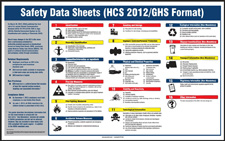| The Home page of ILPI's Safety Data Sheet (SDS) Resource, the leader in SDS information since 1995! | |
| The history and philosophy behind this resource. | |
| A curated collection of books and reference materials concerning Safety Data Sheets and closely related topics. | |
| Paste your plain text SDS into the SDS-Demystifier, and it will be converted into a hypertext-enriched document with links to detailed explanations of each key term. | |
| An extensive list of frequently asked questions about Safety Data Sheets including regulations, content, compliance, and more. | |
| A humorous take on Safety Data Sheet jargon. Fill in the blanks on our entry form to generate a personalized Unsafety Data Sheet to share with your coworkers. | |
| Since 1995, we've maintained this massive curated list of the best places to find Safety Data Sheets on the Internet. | |
| Way more than a glossary, this hypertext-enhanced resource covers hundreds of SDS-related terms and expert knowledge. Each entry includes both the SDS relevance and links to additional authoritative resources. | |
| Archived results of Safety Data Sheet related polls taken by some of our millions of site visitors | |
| You are here! The OSHA regulations behind SDS regulations, including the inspection guidelines and over 400 official interpretations letters under the Hazard Communication Standard | |
| Commercial suppliers of SDS authoring and management software as well as cloud compliance services. | |
| Commercial companies that will create SDS's for your specific needs as well as SDS translation companies. |

Safety signs, banners, and scoreboards? Get yours at Safety Emporium!
| Title: 02/10/2015 - Use of multiple countries' information on labels of hazardous chemicals | |
| Record Type: Interpretation | Standard Number: 1910.1200; 1910.1200(f)(1); 1910.1200(f)(2); 1910.1200(g)(1) |
OSHA requirements are set by statute, standards and regulations. Our interpretation letters explain these requirements and how they apply to particular circumstances, but they cannot create additional employer obligations. This letter constitutes OSHA's interpretation of the requirements discussed. Note that our enforcement guidance may be affected by changes to OSHA rules. Also, from time to time we update our guidance in response to new information. To keep apprised of such developments, you can consult OSHA's website at https://www.osha.gov
February 10, 2015
Ms. Tammy L. Blakeslee, President
EnviroNet LLC
P.O. Box 386 M.O.
Shrewsbury, Massachusetts 01545
Dear Ms. Blakeslee:
Thank you for your October 24, 2014, letter to the Occupational Safety and Health Administration (OSHA). Your letter was referred to OSHA's Directorate of Enforcement Programs for an interpretation of OSHA's Hazard Communication standard (HCS 2012, 29 CFR 1910.1200. This letter constitutes OSHA's interpretation only of the requirements discussed and may not be applicable to issues not delineated within your original correspondence. Your paraphrased questions and our responses are below.
Scenario: Your company has a chemical that is packaged in pre-printed bags, which are made to stock and then shipped around the world. In order to reduce relabeling and repackaging, you would like the chemical label to include the chemical hazard classifications for the United States (U.S.), European Union (E.U.), and China in clearly marked separate boxes.
Question 1: Is it acceptable to have other countries' hazard classifications in addition to the U.S. HCS 2012 classification, on a chemical product label?

Ensure your workers are trained with safety posters and more at Safety Emporium.
Response: The HCS 2012 requires chemical manufacturers, importers, or distributors to ensure that each container of hazardous chemicals leaving the workplace is labeled, tagged or marked with the following information: product identifier; signal word; hazard statement(s); precautionary statement(s); and pictogram(s); and name, address and telephone number of the chemical manufacturer, importer, or other responsible party. 29 CFR 1910.1200(f)(1). The HCS 2012 does not prohibit a manufacturer or importer from adding supplemental information to a label, as long as it does not lead to unnecessarily wide variation or undermine the required label information. Section C.3.1 of Appendix C to HCS 2012 explains that supplementary information may only be added to a label if it provides further detail and does not contradict or cast doubt on the validity of the required information. Therefore, if the other countries have hazard classification information that contradicts or casts doubt on the HCS 2012 information, it is not permitted to be on the label. You may wish to review OSHA's January 31, 2013, letter of interpretation (enclosed) to Ms. Erin McVeigh on this subject.
Question 2: A metal alloy is not hazardous in its shipped form, but may release a hazardous chemical when processed downstream . In classifying a metal alloy, must the classifier evaluate the hazards related to processing?
Response: Yes. A manufacturer or importer must consider the hazards of a chemical during normal conditions of use or in a foreseeable emergency. 29 CFR 1910.1200(b)(2). The hazards related to normal processing (e.g. welding, grinding) must be considered in conducting the hazard classification. You may wish to review two past letters of interpretation on this subject: OSHA's March 11, 1986, letter (enclosed) to The Honorable John H. Chafee, and the November 16, 1994, letter (enclosed) to Ms. Sheila Loftus.
Thank you for your interest in occupational safety and health. We hope you find this information helpful. OSHA requirements are set by statute, standards, and regulations. Our interpretation letters explain these requirements and how they apply to particular circumstances, but they cannot create additional employer obligations. This letter constitutes OSHA's interpretation of the requirements discussed. Note that our enforcement guidance may be affected by changes to OSHA rules. Also, from time to time we update our guidance in response to new information. To keep apprised of such developments, you can consult OSHA's website at https://www.osha.gov.
If you have any further questions, please feel free to contact the Office of Health Enforcement at (202) 693-2190.
Sincerely,
Thomas Galassi, Director
Directorate of Enforcement Programs
Enclosures
The original official public domain version of this document is available from OSHA at https://www.osha.gov/laws-regs/standardinterpretations/2015-02-10-1.